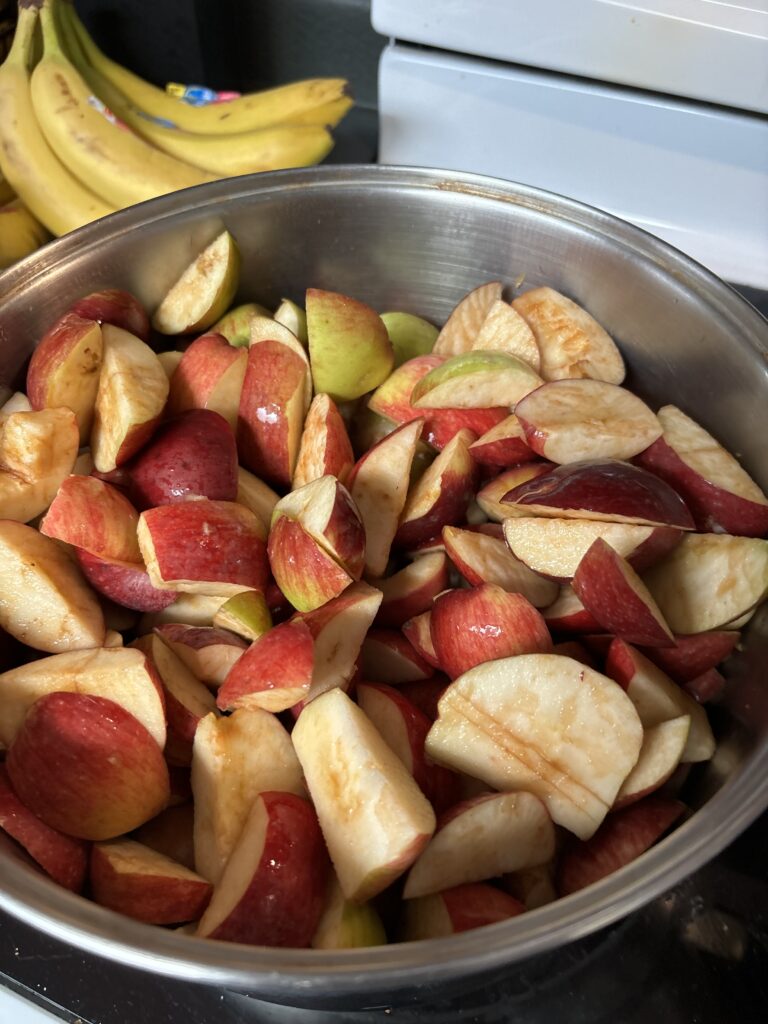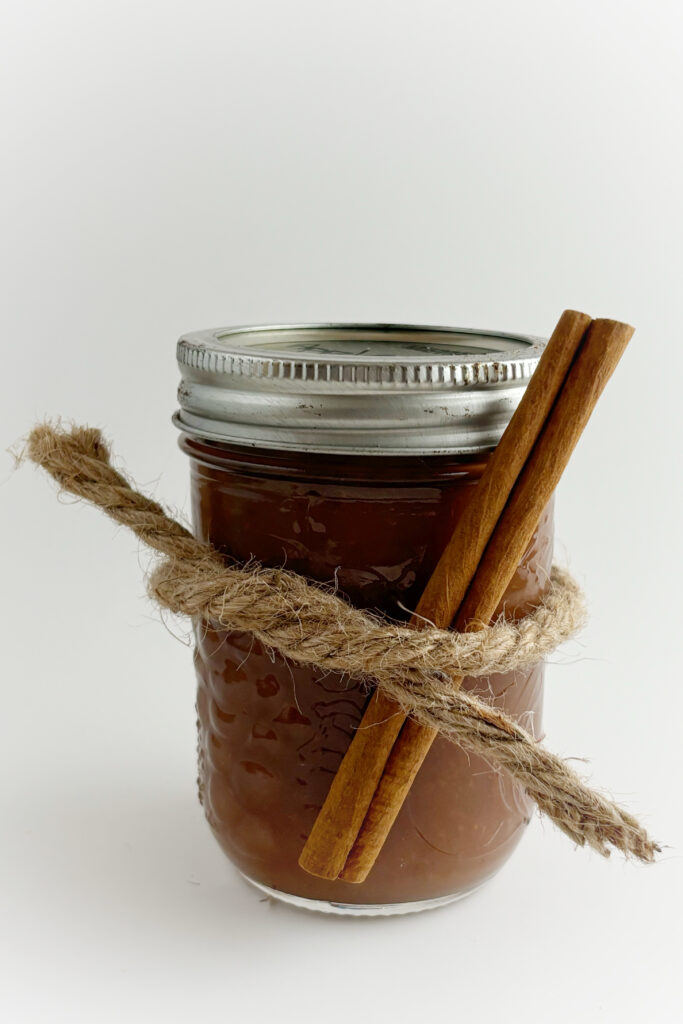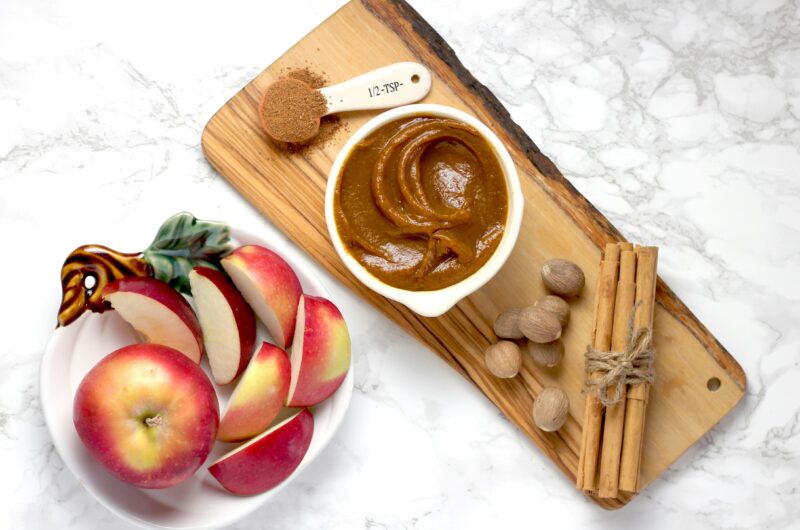Apple butter is one of those timeless kitchen creations that carries the warmth of home in each spoonful. For many of us, the scent of simmering apples brings back cherished memories, like watching my grandmother slowly cook apples until they transformed into a deep, rich spread. I loved her apple butter for its simplicity, its versatility, and the way it made everything from morning toast to a bowl of vanilla ice cream taste like a cozy, spiced celebration of autumn.
Jump to RecipeThe Beauty of a Simple Recipe
Sometimes, the simplest recipes are the best. Apple butter requires only a few ingredients and some time to allow the apples to cook down and caramelize. Unlike some recipes that rely on lemon to keep the apples from browning, apple butter skips that step, embracing the natural color change that occurs as the apples simmer. In the end, everything will turn a lovely shade of brown, creating a spread that tastes even better than it looks.
Beyond being easy to make, apple butter is also a fantastic way to use up an abundance of apples. Whether you have apples from a trip to an orchard or just a surplus from the grocery store, apple butter allows you to transform those apples into something that will last for weeks, even months. Let’s dive into the essentials for making apple butter and look at a few ways to put a unique spin on this comforting classic.
A Basic Apple Butter Recipe
The key to a good apple butter recipe lies in cooking the apples low and slow, allowing the natural sugars to caramelize and the flavors to deepen. While each family has its own take, the following recipe provides a solid foundation.

Ingredients:
- Optional: a pinch of ground allspice or cardamom for added warmth
- 4-5 pounds of apples (choose a blend of sweet and tart varieties)
- 1 cup of apple cider or water
- 1 to 1 ½ cups of sugar (adjust based on your taste and the sweetness of your apples)
- 2 teaspoons ground cinnamon
- ¼ teaspoon ground cloves
- ¼ teaspoon ground nutmeg
- ¼ teaspoon salt
Instructions:
- Prepare the Apples: Core and chop the apples; you can leave the skins on, as they’ll break down during cooking or can be blended later for a smoother texture.
- Cook the Apples: Place the chopped apples in a large pot or slow cooker with the apple cider or water. Cook on medium heat until the apples start to soften, then lower the heat and cover, letting them cook until they are very soft, stirring occasionally.
- Add the Sugar and Spices: Once the apples have broken down, add sugar, cinnamon, cloves, nutmeg, and salt. Adjust the amount of sugar based on how sweet you like your apple butter and the flavor profile of your apples.
- Reduce the Mixture: Uncover the pot, stirring occasionally, and continue cooking on low heat. As the mixture thickens and darkens, you’ll see it turning into that classic apple butter consistency.
- Blend to Perfection: Use an immersion blender or a regular blender (carefully, if hot) to blend the apple mixture until smooth. If you prefer a chunky apple butter, skip this step.
- Continue Cooking: To achieve a thicker consistency, continue cooking after blending, stirring regularly to prevent sticking. The longer it cooks, the richer and thicker the butter will become.
- Cool and Store: Once done, allow the apple butter to cool. Transfer it to sterilized jars and store in the fridge for up to three weeks, or process in a water bath for longer storage.
Customizing Your Apple Butter
The beauty of apple butter lies in its adaptability. While cinnamon, cloves, and nutmeg are classic spices for this spread, you can play with different spice blends to make it your own. Here are a few variations:
Classic Cinnamon-Only Apple Butter: Keep it simple with just cinnamon. This creates a light, versatile spread that lets the apple flavor shine.
Chai-Inspired Apple Butter: Add a mix of cinnamon, cardamom, and a hint of ginger. This combination gives the apple butter a cozy, exotic twist, reminiscent of chai tea.
Warm Autumn Spices: A blend of allspice, nutmeg, and cloves brings out the flavors of a classic apple pie, making each bite feel like a mini dessert.
Bold and Spicy Apple Butter: For a spicier spread, increase the cloves or add a touch of ground black pepper. This works well as a condiment for savory dishes like roast pork.

How to Enjoy Apple Butter
One of the best things about apple butter is its versatility. Here are a few ways to enjoy it beyond the classic toast:
- On Breakfast Foods: Spread it on warm toast, muffins, pancakes, or waffles. It’s a fantastic topping for oatmeal or overnight oats, adding natural sweetness and flavor.
- As a Dessert Topping: Apple butter pairs beautifully with vanilla ice cream, pound cake, or crepes. Swirl a spoonful into yogurt for a quick, fall-inspired treat.
- In Savory Dishes: Use it as a glaze for roasted meats like pork or chicken. The sweetness of the apple butter adds depth and complexity to savory dishes.
- In Baking: Apple butter works as a filling for thumbprint cookies, a spread for pastries, or even as an ingredient in cakes and muffins.
Preserving and Sharing Apple Butter
Since apple butter is often made in larger batches, it’s a wonderful gift for friends and family. You can preserve apple butter by canning it in sterilized jars, making it a lasting treat that you can enjoy throughout the year. Plus, gifting a homemade jar of apple butter is a thoughtful way to share the season’s bounty and your love of homemade traditions.
Tips for Perfect Apple Butter
- Choosing the Right Apples: A blend of apples works best for apple butter. Tart apples like Granny Smith or McIntosh add a bit of tang, while sweeter varieties like Fuji or Honeycrisp bring natural sweetness.
- Adjusting for Thickness: If you want a thicker apple butter, you can cook it down longer or even cook it uncovered for the final hour to evaporate more moisture.
- Sweetness and Spice Levels: Feel free to adjust the sugar and spices to suit your taste. Taste as you go, especially if you’re trying a new spice blend.
A Tradition Worth Keeping
For me, apple butter is more than just a spread; it’s a reminder of family and simpler times. Watching my grandmother carefully simmer her apple butter, tasting it as it thickened, and filling jars with the fragrant, spiced spread was an experience filled with warmth and nostalgia. And now, each time I make apple butter, I get to recreate those memories and pass them along.

Whether you’re making it for yourself, preserving it for later, or giving it as a gift, apple butter is a versatile, delicious way to make the most of fall’s apple harvest. So, gather your apples, choose your spices, and set aside a cozy afternoon for this slow, rewarding process. It’s a tradition worth keeping and a recipe that will keep your autumn flavors alive all year long.
Thinking of preserving your apple butter? Check out our introduction to canning jars, lids and pressure cookers here.
Apple Butter Recipe
Difficulty: EasyFor the most delightful apple butter, you’ll need:
Ingredients
5 lbs your favourite apples
1 cup water
1-1.5 cups brown sugar
1tbsp vanilla
1/2 tbsp cinnamon
1/8 tsp clove (opt)
1/8 tsp nutmeg (opt)
Directions
- Wash your apples
- Slice and core the apples and place in an insulated pot on medium
- Add the rest of the ingredients, including spices, to the pot
- Cook, stirring occasionally, until apples are soft (approx 30 mins)
- With an immersion blender, blend the apples into applesauce. If you don’t have an immersion blender, a standard blender can be used. Return applesauce to the pot.
- Turn your burner down to low and allow to cook uncovered for 10-12 hours.
- When the apple butter is a deep brown and has reached your preferred thickness, turn off the heat and allow to cool. The mixture will thicken slightly once cooled.


